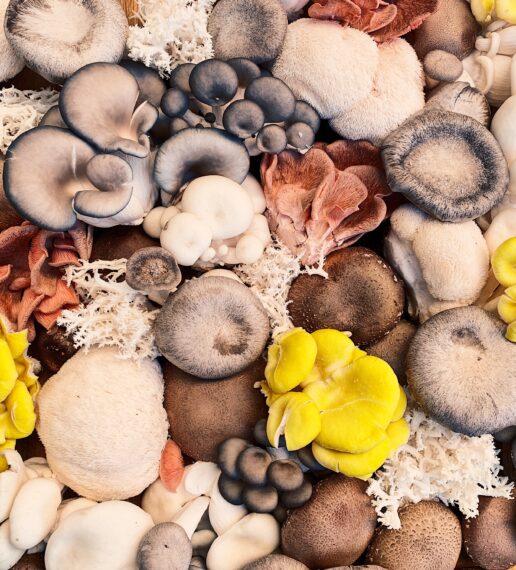Exploring (MORE) Exotic Mushroom Farms – Shiitake, Cordyceps and Shaggy Mane
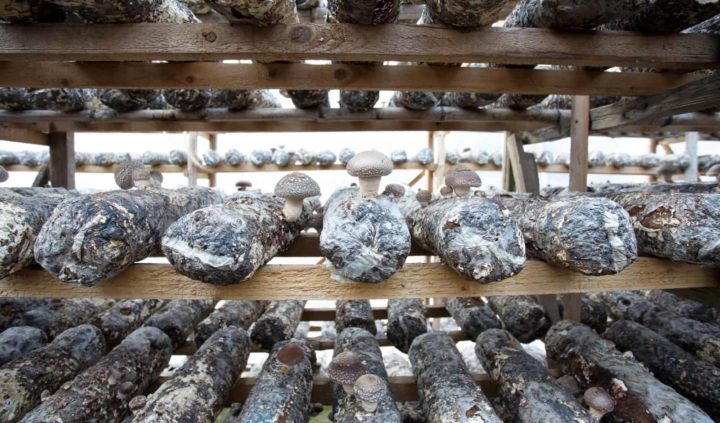
I don’t know about you, but I feel like it’s about time to go on another mushroom adventure.
A little while back I posted a video about 6 “low tech” mushroom farms, and I wasn’t able to cram in everything I wanted to show you into that one video.
As promised, I have a few other really cool places for you to see, including an insanely productive Shiitake farm, and a super neat museum with quite possibly the largest collection of mushroom specimens in the world. We’ll also take a quick look at Shaggy Mane farm, and perfectly optimized Cordyceps militaris farm where they are doing something quite difficult but making it look super easy.
History of Shiitake Cultivation
The “artificial logs” are made of a substrate of hardwood sawdust that has been supplemented with wheat bran and millet. This allows for producing way more shiitake at a much faster rate than you would expect from the traditional method that used real logs.
The name shiitake is actually derived from Japan where it was grown on the shii tree. “Take” means “fungus of” thus the name shiitake meaning fungus of the shii tree.
But the origin of Shiitake cultivation actually goes WAY back to over 800 years ago in the province of Qingyan China, where the method for cultivation was first discovered by Wu San Kwang.
He knew that Shiitake grew on fallen logs in the forest and discovered that when he cut the logs the mushrooms that grew on the logs were larger and better. But as the story goes, sometimes, despite the cuttings, the mushrooms would still not grow, so he would beat the logs furiously.
Surprisingly, he found that this caused huge fruitings of mushrooms all over the logs a few days after hitting them. This is said to be the origin of the ‘shocking method” or the “soak and strike” method where hardwood logs are inoculated, soaked, and “shocked” fruiting.
This discovery brought a ton of prosperity to the area, and is still celebrated today. In fact, they even have a museum that documents the history of Shiitake and the importance it still holds in this region.
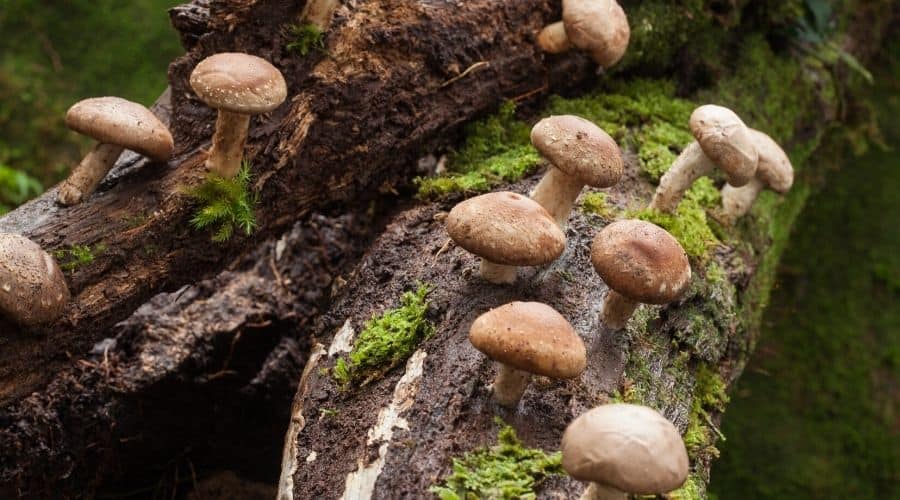
Mushroom Museum
In this area, there is also a temple that is dedicated to Wu Sang Kwang, where people go to give offerings and bring good harvests to their mushrooms.
Shiitake is still cultivated widely there today, although they now use different more advanced methods, there are shiitake farms absolutely everywhere that there is room for it.
Since this area of Qingyuan has such a rich history of mushroom cultivation, they have also built a mushroom museum that explores the history of Shiitake, but also has quite possibly the world’s largest collection of mushroom fruiting bodies. They are all suspended in liquid and preserved indefinitely. They had so many different species, basically, any that you could think of was there.
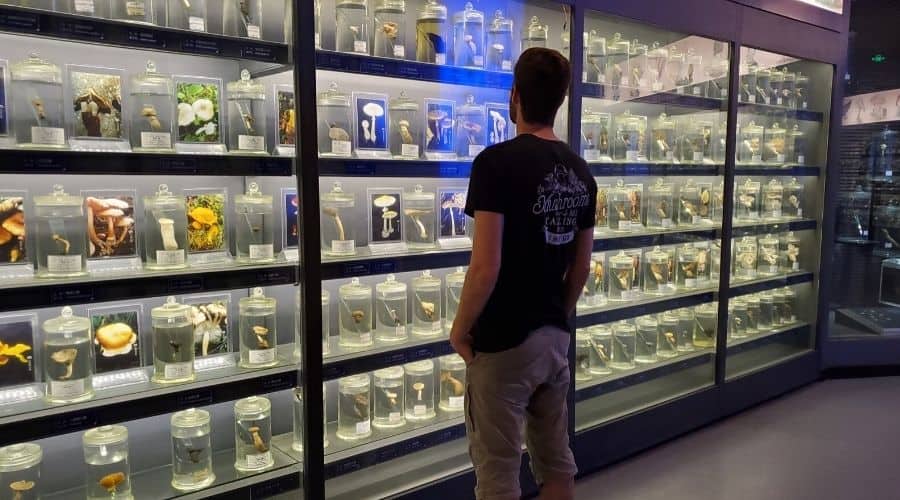
An Efficient Cordyceps Militaris Farm
Let’s switch gears here and drop by a modern and efficient Cordyceps militaris farm.
I have shown this farm in a few other YouTube videos, specifically this one about the difference between Cordyceps militaris and Cordyceps sinensis which you should check out if you want to know the difference and why it matters.
This particular farm was growing Cordyceps militaris, which is a medicinal mushroom used for energy and endurance*. It is not the easiest species to grow, but this farm had it down to a science. First the substrate is prepared by taking rice and soy and sterilizing it with steam. The substrate is then inoculated with the Cordyceps mushroom culture, and eventually fruited by taking into a cold room with blue lights.
And when I say cold, I mean like 13 degrees celsius or about 55 deg F. The cooler temperature causes the Cordyceps to grow super slow, and actually increases the concentration of beneficial compounds like Cordycepin- one of the powerful medicinal compounds found in Cordyceps militaris.
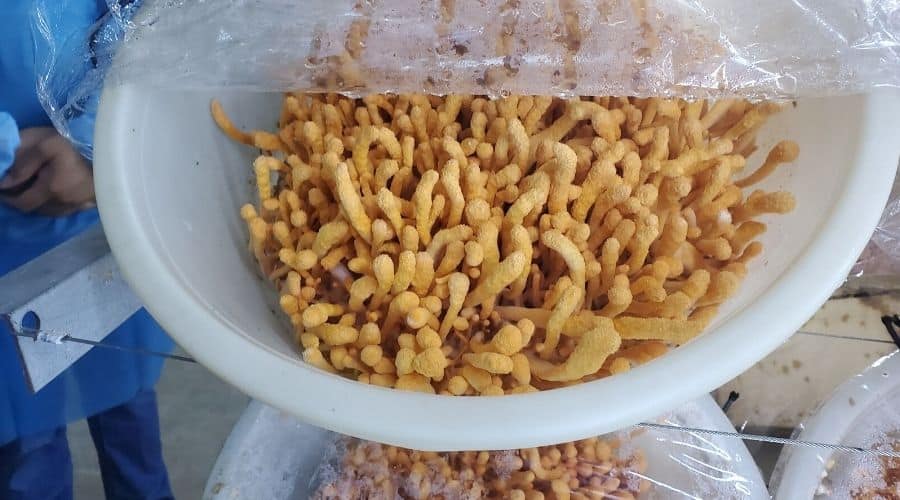
The blue light is helpful to cause the mushrooms to pin. Cordyceps is a valuable mushroom, but cultivating it like this allows for the mushroom to be reasonably consumed as a medicinal mushroom. Otherwise, if it needed to only be found in the wild, it would be way too expensive to be feasible.
Cordyceps is also neat in the way that you need to continue cloning and growing out the mushroom for the culture to be viable. This farm was cloning and creating a new culture about every 3-6 months. If the culture is left too long without being grown out, it will eventually fail to produce any fruits.
Shaggy Mane Farm (Coprinus comatus)
Last but not least, I want to take you to a Coprinus comatus farm, more commonly known as Shaggy Mane. I didn’t quite get enough footage of this farm, and it wasn’t in full production, so it doesn’t look like much, but I still wanted to share it.
Typically Shaggy Mane is grown in the winter months because it prefers cooler weather, but when I was at this farm it was HOT, smack dab in the middle of summer.
What I was most surprised about was what the mushrooms were growing on and how they were being cultivated. When I have previously grown Shaggy mane, I have done it on manure based substrates, because based on the life cycle of the mushroom, and how it grows in the wild, that is what you would think is the best substrate.
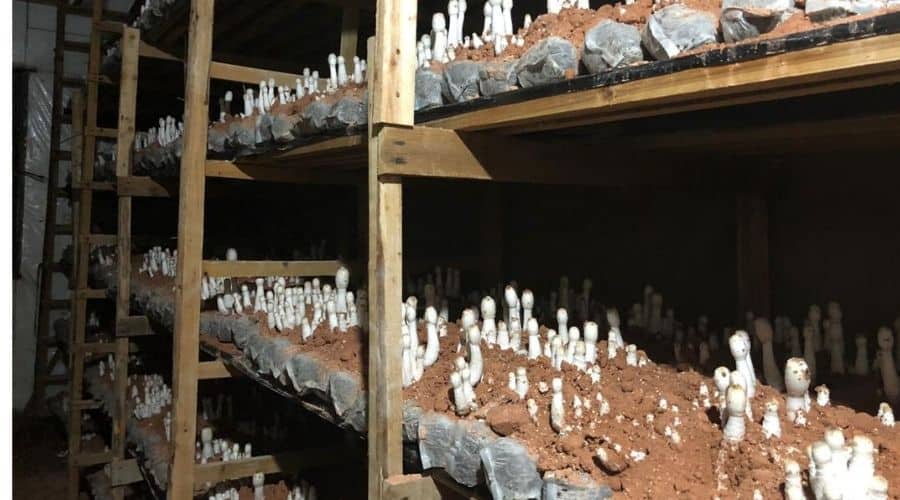
On this farm, they were growing it on hardwood sawdust, similar to what you would use to grow shiitake, maitake, or many other gourmet species. The bags were slit along the top, and buried under a thin layer of soil, which I would guess is to maintain humidity around the pins when they are forming.
Shaggy Mane is never sold fresh because of the way it degrades so quickly after harvest- if you want to eat it fresh you basically need to harvest it yourself. At this farm, they dried everything to a crisp, and then sold the dried and packaged mushrooms.
